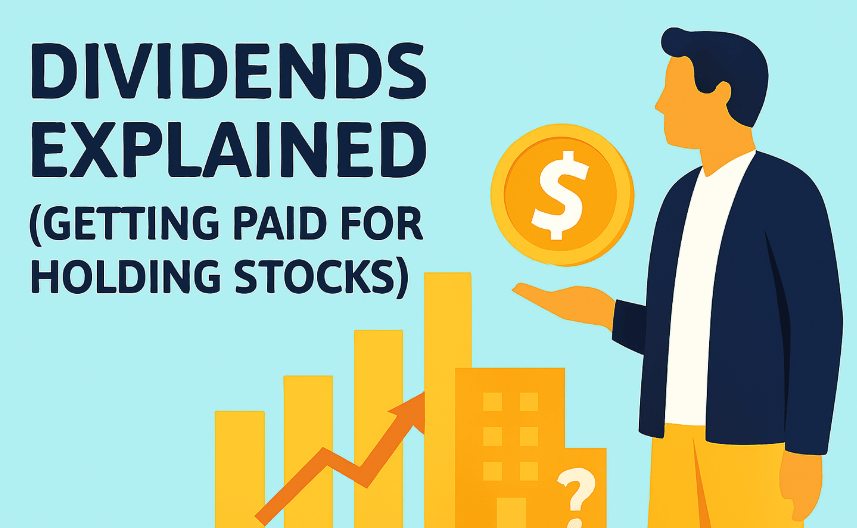- Live Life Grow Wealth
- Posts
- 💸Series 2 Day 3: Dividends Explained — Getting Paid for Holding Stocks
💸Series 2 Day 3: Dividends Explained — Getting Paid for Holding Stocks

Today’s Headline
💸 Series 2: Stock Market Basics
Day 3: Dividends Explained — Getting Paid for Holding Stocks
When I first started investing, someone told me, “Imagine getting paid just for owning a stock.”
I laughed. “You mean I don’t have to sell it to make money?”
That’s when I learned about dividends—one of the most beautiful and powerful concepts in investing. Dividends are like thank-you payments that companies give to their shareholders for believing in them.
You’re not working for it. You’re not trading for it. You’re simply getting paid for owning a piece of a business.
"Innovative Ways to Diversify Your Portfolio: Investing in Media and Advertising Trends"
Highlight the growth potential of advertising platforms like Roku as a sector worth exploring for savvy investors.
Find your customers on Roku this Black Friday
As with any digital ad campaign, the important thing is to reach streaming audiences who will convert. To that end, Roku’s self-service Ads Manager stands ready with powerful segmentation and targeting options. After all, you know your customers, and we know our streaming audience.
Worried it’s too late to spin up new Black Friday creative? With Roku Ads Manager, you can easily import and augment existing creative assets from your social channels. We also have AI-assisted upscaling, so every ad is primed for CTV.
Once you’ve done this, then you can easily set up A/B tests to flight different creative variants and Black Friday offers. If you’re a Shopify brand, you can even run shoppable ads directly on-screen so viewers can purchase with just a click of their Roku remote.
Bonus: we’re gifting you $5K in ad credits when you spend your first $5K on Roku Ads Manager. Just sign up and use code GET5K. Terms apply.
🧠 What Exactly Is a Dividend?
A dividend is a portion of a company’s profits that’s paid to shareholders.
When a company makes money, it can do two things with that profit:
Reinvest it back into the business to grow.
Share a portion of it with its owners (that’s us, the shareholders).
That shared portion is called a dividend. It’s usually paid in cash, straight into your brokerage account, just like receiving a paycheck.
Think of it as your reward for trusting the company with your money.
🏦 Why Companies Pay Dividends
Not every company pays dividends—but those that do often have one thing in common: stability.
Companies that pay dividends are usually mature and profitable. They don’t need to reinvest every dollar because they’re already doing well. So instead, they share part of their profits to keep investors happy.
Some reasons companies pay dividends:
To reward loyal shareholders.
To show financial strength.
To attract investors who want steady income.
In short, dividends are a company’s way of saying, “We’re doing well, and we want to thank you for believing in us.”
💵 How Dividends Are Paid
Dividends are typically paid every quarter—that’s four times a year.
For example:
If you own 100 shares of a company and it pays a dividend of $1 per share annually, you’ll receive $25 every quarter (since $1 ÷ 4 = $0.25 each quarter).
It might not sound like much at first, but over time, those small payments can add up to a lot—especially when you reinvest them.
Some companies also pay special dividends once in a while, like a bonus when they’ve had an exceptionally good year.
💰 Dividend Yield — The “Interest Rate” of Stocks
When you buy a dividend-paying stock, you’ll often see something called a dividend yield.
It’s simply the dividend amount divided by the stock price, shown as a percentage.
For example:
A $100 stock that pays $5 in dividends per year has a 5% dividend yield.
That means if you invest $1,000, you’d get $50 a year in dividend income (not counting price changes).
So, dividend yield helps you compare how much income different stocks generate.
📈 The Magic of Reinvesting Dividends
Here’s where things get powerful.
Instead of spending your dividends, what if you reinvest them to buy more shares of the same company?
That’s called dividend reinvestment, and it’s one of the easiest ways to grow your wealth without adding extra money.
Here’s how it works:
You get dividends →
They buy more shares →
Those new shares also pay dividends →
The cycle repeats and grows bigger over time.
This is the power of compound growth—earning returns on your returns. It’s like planting a money tree that keeps giving you more seeds each season.
🌳 Example of Compounding with Dividends
Let’s imagine you invest $10,000 in a stock with a 5% dividend yield.
If you reinvest every dividend and the stock price grows 5% a year, in 20 years your investment could grow to nearly $27,000—without adding another dollar.
That’s the quiet power of letting time and dividends work together. You don’t need to chase the market or trade daily. You just need patience.
🏆 Dividend Aristocrats — The Kings of Consistency
Some companies have been paying and increasing dividends for decades.
They’re called Dividend Aristocrats—businesses so reliable that they’ve raised dividends every single year for at least 25 years.
These are companies like household brands you use every day—strong, trusted names that have weathered recessions, crises, and still kept paying their shareholders.
They might not be flashy, but they’re dependable. And in investing, dependability matters more than excitement.
Become an email marketing GURU.
Join us for the world’s largest FREE & VIRTUAL email marketing conference.
Two full days of email marketing tips & trends, famous keynote speakers (Nicole Kidman!), DJ’s, dance contests & networking opportunities.
Here are the details:
100% Free
25,000+ Marketers
November 6th & 7th
Don’t miss out! Spots are LIMITED!
🧩 Why Dividends Matter for Investors
Dividends do three important things for you:
Provide steady income – You get paid regularly even if the stock price doesn’t move.
Reduce risk – Dividend payments cushion you during market downturns.
Encourage long-term thinking – You’re rewarded for holding, not selling.
This is why many investors prefer dividend stocks—they offer both income and growth potential.
It’s like getting rent from a property you own, except it’s much simpler.
💬 Dividends vs Capital Gains
There are two main ways to make money from stocks:
Capital gains – When you sell your stock at a higher price than you bought it.
Dividends – When the company pays you directly for holding.
Capital gains depend on timing. You need to sell at the right time.
Dividends depend on ownership. You just need to hold.
That’s why many investors combine both—own good companies that grow and pay dividends.
You get the best of both worlds.
💡 Not All Companies Pay Dividends
It’s important to know that not every company pays dividends—and that’s okay.
Younger companies or fast-growing tech firms often don’t pay dividends because they reinvest all their profits into expansion.
It doesn’t mean they’re bad investments—it just means their growth strategy is different.
Think of dividend-paying companies as mature trees giving fruit, and growth companies as young trees still growing roots. Both have their place in your garden.
🧾 Understanding Ex-Dividend Dates
If you plan to buy dividend stocks, you need to understand a few key dates:
Declaration date – When the company announces the dividend.
Ex-dividend date – The cutoff date to be eligible. You must own the stock before this date to receive the dividend.
Payment date – When the dividend is actually paid out.
Missing the ex-dividend date means you’ll miss that round of payments.
So always check these dates before buying.
“Unlock access to top-tier startup deals before VCs catch on — click here to explore what VentureScout is quietly revealing to serious investors.”
|
📉 When Dividends Aren’t Always Good
Now, here’s something most beginners don’t realize: not all dividends are created equal.
Some companies pay high dividends to attract investors, even when they can’t really afford it. That can be a red flag.
If a company’s profits are falling but it keeps paying big dividends, it might be using debt to do so. Eventually, that becomes unsustainable.
So when you see a very high dividend yield—say 10% or more—be cautious. Ask:
Can the company afford it?
Is it still growing?
Has it maintained dividends consistently in the past?
A healthy dividend is one that’s sustainable—supported by real profits.
⚖️ How to Find Good Dividend Stocks
When I look for strong dividend stocks, I usually check three things:
Dividend track record – Has the company been paying consistently for years?
Payout ratio – How much of its earnings go to dividends? (A ratio below 70% is generally healthy.)
Business strength – Is the company growing and profitable?
If a company checks these boxes, it’s usually a safe long-term bet.
🔄 The Habit of Reinvesting
Some brokers offer a Dividend Reinvestment Plan (DRIP), where your dividends automatically buy more shares.
You don’t have to do anything—it’s completely passive.
This habit builds wealth slowly but surely. You’re compounding without even realizing it.
Many millionaires built their fortune not through luck, but through years of consistent reinvestment.
📉 What Happens to Stock Prices After Dividends
Here’s an interesting fact: when a company pays a dividend, its stock price usually drops by roughly the same amount on the ex-dividend date.
For example, if a $100 stock pays a $1 dividend, it might open at $99 the next day.
This is normal—it reflects that the company’s cash is now distributed to shareholders.
But long term, this small drop doesn’t matter because you’ve already received that value in cash.
🧘 The Emotional Side of Dividends
There’s something psychologically rewarding about receiving dividends.
Even during market downturns, you still get paid. You’re not just watching your portfolio value change—you’re collecting real income.
That steady flow gives investors confidence to hold on, instead of panic selling.
It’s one of the reasons dividend investing feels peaceful compared to day trading. You’re earning while you wait.
📊 Building a Dividend Portfolio
You can build a dividend portfolio that pays you regularly, almost like a second income stream.
Here’s how:
Pick 10–15 strong, dividend-paying companies across different sectors.
Reinvest all dividends.
Hold for the long term (at least 5–10 years).
Review once or twice a year—no need for daily trading.
Over time, your dividend income will grow as companies raise their payouts and your ownership increases.
That’s how ordinary investors quietly become financially independent.
🧠 Common Mistakes to Avoid
A few common mistakes I see:
Chasing the highest yield without checking company quality.
Ignoring dividend consistency and payout ratio.
Selling too quickly instead of reinvesting.
Forgetting to diversify across industries.
Remember, dividend investing is a marathon, not a sprint. The goal is steady, reliable growth—not overnight riches.
💬 Real-Life Example
Imagine owning shares of a solid company like a food or beverage giant that’s been paying dividends for 40 years.
Even if the market goes up or down, that company keeps earning and paying you.
Every three months, you see money land in your account—not from trading, but from ownership.
That’s the true meaning of financial independence—your money working for you, not the other way around.
🧭 Takeaway and Advice
Here’s what I want you to remember from today’s lesson:
Dividends are your reward for owning part of a business.
They can provide consistent income and stability.
Reinvesting dividends can create powerful compounding growth.
Focus on quality, not just high yields.
Patience and consistency are your greatest allies.
If you understand dividends, you’ll stop seeing stocks as “buy low, sell high” bets—and start seeing them as income-producing assets that can fund your future.
Final Takeaways
Dividends are proof that wealth doesn’t come from luck—it comes from patience, ownership, and time.
You don’t need to trade every day or guess the next hot stock. You just need to own great businesses that share their success with you, year after year.
Every dividend you earn brings you one step closer to financial freedom.
💬 Call to Action
Here’s your small action step today:
Go through your watchlist or portfolio and pick one dividend-paying stock. Research its dividend history, payout ratio, and yield.
Ask yourself, If I held this for 10 years, would I be proud to own it?
Start small, stay consistent, and remember—dividends are the quiet engine that builds lasting wealth.
[Live Life Grow Wealth]
🎓 Free Masterclasses to Unlock Your Investment Potential
Take your money skills to the next level with expert-led workshops designed to help you grow smarter and faster.

Recommendations Section
|
|
|
|
DISCLAIMER
I make no representations, warranties, or guarantees, whether expressed or implied, that the content provided is accurate, complete, or up-to-date. Past performance is not indicative nor a guarantee of future returns.
I am an individual content creator and not regulated or licensed by the Monetary Authority of Singapore (MAS) as I do not provide investment services.
All forms of investments carry risks, including the risk of losing your entire invested amount. Such activities may not be suitable for everyone. You are strongly encouraged to seek advice from a professional financial advisor if you have any doubts or concerns.










